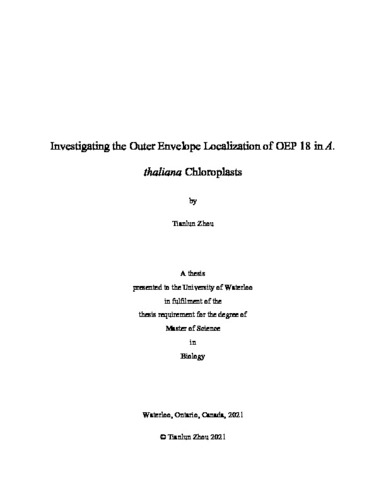| dc.description.abstract | Plastids are plant organelles with specialized functions including photosynthesis. The specialized function of each plastid is informed by its distinct and dynamically regulated proteome. The majority of plastid proteins are synthesized in the cytosol and are imported into the plastid post-translationally. A variety of receptors and channels embedded within the plastid outer and inner envelope membranes regulate the import of plastid proteins, and thus control the plastid proteome composition. There are 117 known Outer Envelope Proteins (OEPs) that reside in the chloroplast outer membrane. Of these 117 OEPs, only a few have been extensively studied regarding their targeting. With the exception of Toc75, which uses the general pathway involving an N-terminal cleavable transit peptide (TP) for targeting, the OEPs that have been studied so far either use the signal-anchored, tail-anchored, or β-barrel pathway for targeting. However, previous studies showed that a key component of the translocon at the outer envelope of chloroplasts (Toc complex), Toc159, possesses a novel reverse TP-like sorting signal and an unconventional membrane anchor within the C-terminus for its own targeting and insertion into the outer membrane. Moreover, recent studies using bioinformatics tools predicted that eight additional OEPs also contain transit peptide-like sequences at their C-termini. Transient expression assays in Arabidopsis mesophyll protoplasts demonstrated that one of the candidates, OEP18, appears to be targeted to the chloroplast outer membrane using such a signal. My research was able to determine the precise subcellular location of OEP18 using protoplast transient expression assays, chloroplast fractionation, and Western blot analysis. Secondary structure and membrane topology prediction analyses for all 117 OEPs were also used for grouping according to their targeting pathways. My research also determined that the predicted reverse TP region of OEP18 is responsible for specific targeting to the chloroplast outer membrane, but not its anchoring. These findings will allow for a better understanding of protein targeting to the outer membrane of chloroplasts. | en |

